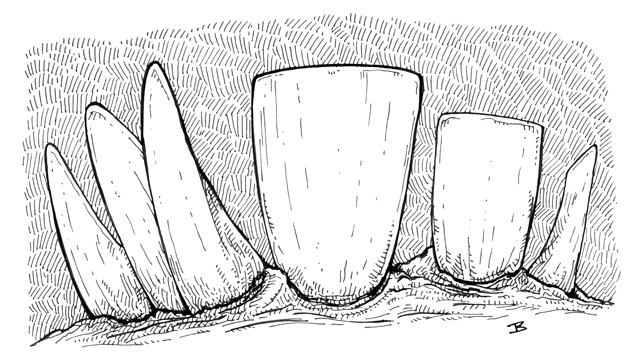In your average FRPG there are always
plenty of monsters that will readily eat adventurers. This is
handy for the DM, but perhaps less so for the players. I started wondering whether the average dungeon ecosystem might also be home to things that adventurers could possibly eat. With that in
mind, I've had a go at designing a bunch of creatures that may be a
useful source of sustenance for those poor dungeoneers who are bored to tears with iron
rations. But, as there's no such thing as a free lunch, each of these 'foods' will have to be treated with a little caution.
I've written them up in classic 1E Monster Manual style, which has also influenced the look and feel of the artwork. Enterprising DMs should be able to adapt them to their
preferred system. I'd be very happy to hear about that!
I'll add a new monster each week, starting with the...
GOURDBUG
FREQUENCY: Uncommon
NO. APPEARING: 2-16
ARMOR CLASS: 6
MOVE: 12"
HIT DICE: 1
% IN LAIR: 40%
TREASURE TYPE: Nil
NO. OF ATTACKS: 1
DAMAGE/ATTACK: None
SPECIAL ATTACKS: None
SPECIAL DEFENSES: Glue
MAGIC RESISTANCE: Standard
INTELLIGENCE: Animal
ALIGNMENT: Neutral
SIZE: S (6 -12" long)
PSIONIC ABILITY: Nil
Attack/Defense Modes: Nil
Legend insists that Gourdbugs must have been created by a lawful good Magic User or deity, as they are such incredibly useful creatures. However, as Gourdbugs prefer to live and feed in caves and other places thick with ordure and waste, they can sometimes be found alongside other more dangerous creatures (such as Otyughs). Gourdbugs derive their name from the large sac that grows from their back, which they can burst at will and cover any attacker in a powerful glue-like sap if the creature is threatened or handled incorrectly. This does no harm to the Gourdbug, which grows another sac within 1-6 days. The sap not only has a pleasing taste but can be used to repair bowstrings, clothing, spear sockets and similar items, and is very resilient to heat, damp and cold. It can be dissolved by any liquid that contains alcohol, although this takes quite some time (2-12 hours). Careful hunters know that the Gourdbug must be picked up by its prong-like eye stalks and then gently swung back and forth several times, which causes it to retract its legs and go dormant. Dwarves often hang them from their belts by these stalks. Capturing a Gourdbug is a feat in itself, as they are fast and always try to keep their head facing away from any attacker. They can only be drained via an incision to their underside, which unfortunately also kills the creature but is the only way to preserve the taste of its sap. The sac itself can be removed, dried and used to store liquids, powders and other substances (even those that are poisonous, caustic or acidic). Dissolving the sac in a solution containing alcohol for 1 day causes it to break up into long fibres, which can then be spun for rough thread and stouter chord. A dormant Gourdbug can be kept for 2-8 days before inactivity renders its sap tasteless (although it always retains its glue-like properties). A 12" Gourdbug carries approximately 1 pint of sap, which can usually be sold for 15 s.p. or more. There are several varieties of Gourdbug, each with their own particular taste:
Red: sweet, sugary
Green: spicy, meaty
Blue: red or white wine
Purple: sour, pickle-like
Dwarves have tried to farm Gourdbugs for many years, but to no avail. Attempts to use the Red and Blue varieties as ingredients in brewing have also failed. The creatures seem only to thrive in particular environments and no-one is sure why only those in the wild survive. Adventurers using Gourdbugs as supplies for expeditions will have to carry a great many of them in order to fully supplement their diet, as 4-6 would have to be consumed per day in order to replace rations. Half-orcs find the taste of any Gourdbug very unpalatable and it is thought that this also the case for orcs, goblins, hobgoblins and similar creatures.
Description: Gourdbugs are streaked and mottled with various shades of their basic color. The insect-like parts of their bodies seem polished and robust, whilst the sac appears both fibrous and semi-opaque.
Next week: the H'Malo...






